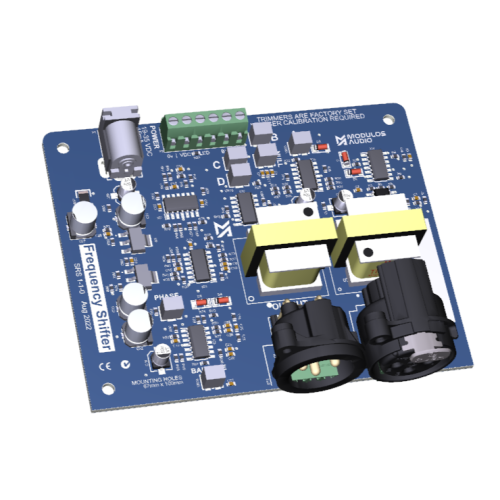Frequency Shifter
Frequency Shifting for feedback control is an age-old proven technique.
Anyone who has ever used or heard a PA (public address) system in an auditorium will be familiar with the phenomenon of acoustic feedback or 'howlround', whenever the gain control is set at too high a level.
Typically an earshattering screech comes from the speakers until the operator reduces the system gain; even then ringing at various frequencies can often be heard whenever the person addressing the gathering speaks into the microphone.
Acoustic feedback occurs when the sound finding its way back to the microphone position from the loudspeakers is equal to or more in level to than coming from the voice of the person at the microphone.
The 'system gain' is then said to exceed unity and positive feedback creates full power oscillation at a resonant frequency of the entire room and PA system. A variety of remedies for acoustic feedback exist, including the use of directional (i.e., cardioid) microphones and the careful placement of loudspeakers to minimise the sound level arriving back at the microphone. Also, a graphic equaliser can be placed in the audio chain, to smooth out the overall response. These methods are effective to varying degrees, but much less so in rooms with noticeable echoes, where reverberation becomes the major cause of feedback problems. The non-directional nature of reverberation means that sound will approach even a cardioid microphone on its front axis and largely negate any placement scheme.
Why shift frequency?
Now there is an important but little-known fact about the acoustics of rooms and auditoriums. If a frequency response sweep of a room is done VERY slowly, it is found to have a fine structure of minor resonances, superimposed on the usual much broader major ones. These narrow band resonances are caused by standing waves set up between the walls and other parallel surfaces of a room. They seriously exacerbate acoustic feedback problems when a PA system is used and can limit the available gain before feedback occurs in even the best systems by 10dB. However, the really interesting fact is that the frequency spacing of these resonances is a constant number of hertz, characteristic of the room and its reverberation time. Generally for most auditoriums the spacing of adjacent peaks is about 10Hz, or 5Hz between adjacent peaks and dips.
If the whole audio spectrum of the signal from the microphone could be shifted by about 5Hz, then the effect of these peaks would be eliminated. A sound going around the microphone-speaker room loop is no longer reinforced each time at a (minor) resonant frequency, but peak being alternately replaced by an adjacent dip. This principle is the basis of frequency shifting.
MSD Frequency Shifter
-

- Brand: Modulos
- Product Code: SRS1.0
- Availability: In Stock
-
$1,100.00
- Ex Tax: $1,100.00
Tags: MSD - Frequency Shifter

